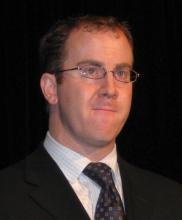SAN ANTONIO – Overall patterns of recurrence are similar regardless of whether patients achieve a pathologic complete response after neoadjuvant therapy for gastric and gastroesophageal junction cancer, results of a retrospective study indicate.
Pathologic complete response (pCR) following preoperative therapy is associated with improved survival in several other solid tumors, including breast, esophageal, lung, and rectal cancer. However, recurrence and survival in patients with gastric or gastroesophageal junction (GEJ) cancer achieving a pCR after preoperative treatment are not well characterized.
To elucidate the pattern and timing of these outcomes, Dr. Ryan Fields and his associates reviewed 2,676 patients in a prospective database who underwent curative resection for gastric/GEJ cancer from 1985 to 2009 at Memorial Sloan-Kettering Cancer Center in New York. Of these, 714 received preoperative chemotherapy with or without radiation, and 105 patients were excluded from analysis for metastatic disease or positive surgical margin. Among the 609 remaining patients, 60 (10%) achieved a pCR and 549 did not.
Achieving a pCR was heavily dependent on tumor location and/or use of preoperative chemoradiation therapy, Dr. Fields said at a symposium sponsored by the Society of Surgical Oncology. A pCR occurred in 17% of patients treated with chemoradiation therapy vs. only 4% undergoing chemotherapy alone. Among the 60 pCR patients, 78% had GEJ and 22% had gastric tumors.
After 46 months of follow-up, 14 of the pCR patients developed a recurrence, with all but 1 occurring within 2 years of surgery. A total of 233 (42%) non-pCR patients had a recurrence.
"In patients that achieve a pCR, there remains a significant rate of recurrence – 27% at 5 years," said Dr. Fields, a surgeon with the center’s gastric and mixed tumor service.
By comparison, the 5-year incidence of recurrence for non-pCR stage I and II patients was 25% and 39% (P = .49 and P = .36, respectively), and reached a full 74% for non-pCR stage III patients (P less than .001).
"The incidence of recurrence between pCR and non-pCR stage I and II patients is really equivalent," said Dr. Fields. "It’s only significantly worse for non-pCR patients who are stage III with involved lymph nodes after preoperative treatment."
The site of first recurrence was local/regional in 43% of both pCR and non-pCR patients (P = 1.0). "I think this speaks to the fact that we still need to consider local/regional surveillance in this patient population, despite the fact that they achieved a complete response," he said.
Five pCR patients and 10 non-pCR patients experienced brain metastases as the site of first recurrence. This represents 36% of all pCR recurrences, compared with 4% of all non-pCR recurrences, a significant difference (P = .01).
Importantly, all of these patients presented symptomatically, with either seizures or focal neurologic deficits, Dr. Fields said. The average time to central nervous system recurrence was 12 months (range 5-24 months), and the average time from recurrence to death after CNS recurrence was 10 months (range 2-26 months).
"These numbers are small – 5 out of 60 patients – but it puts forth the consideration of brain imaging in these patients to try to identify CNS recurrences before the onset of symptoms in this select cohort," he said.
Finally, compared with non-pCR patients, pCR patients experienced significant improvements in disease-specific survival (27% vs. 51%, P = .006) and in recurrence-free survival (73% vs. 51%, P = .01). While survival outcomes as a whole were improved in the pCR patients, all of this can be attributed to the contribution of the non-pCR stage III patients, Dr. Fields noted.
When asked during a discussion of the study what is so special about chemoradiation vs. chemotherapy alone, Dr. Fields replied that the chemotherapy regimens, given alone or with radiation, comprise different drugs and thus would be expected to have different efficacies. In addition, because all the tumors that received radiation were GEJ tumors, it is unclear whether the difference in pCR rate was caused by radiation, tumor location/biology, or both.
"We are certainly finding out that there are significant molecular differences between GEJ and gastric body tumors," he said in an interview. "For example, HER2 expression is quite different between tumors in these locations. Similarly, these tumors may respond very differently to chemotherapy and radiation and give different pCR rates to these treatments."
Dr. Fields and his coauthors disclosed no conflicts of interest.

